- myFICO® Forums
- Types of Credit
- Credit Cards
- Re: Why denials instead of ridiculously low SLs?
- Subscribe to RSS Feed
- Mark Topic as New
- Mark Topic as Read
- Float this Topic for Current User
- Bookmark
- Subscribe
- Mute
- Printer Friendly Page
Why denials instead of ridiculously low SLs?
Is your credit card giving you the perks you want?
Browse credit cards from a variety of issuers to see if there's a better card for you.
- « Previous
-
- 1
- 2
- Next »
- Mark as New
- Bookmark
- Subscribe
- Mute
- Subscribe to RSS Feed
- Permalink
- Report Inappropriate Content
Re: Why denials instead of ridiculously low SLs?
You're trying to overthink this without good data, just a gut "feeling"
Credit card issuers have good data, reams of it. They know how much
it costs to service accounts, how much profit there is in servicing various
segments of the market and how much loss % they are likely to encounter.
They don't do it because the return on investment and risk/reward isn't there.
The business models that do business with higher risk, lower limit customers
are progressively more fee based rather than swipe & APR based. Even they
come to a level where it doesn't pencil out.
 850 FICO8 since 2015, Thanks MyFICO - 5+ years since last HP
850 FICO8 since 2015, Thanks MyFICO - 5+ years since last HP
- Mark as New
- Bookmark
- Subscribe
- Mute
- Subscribe to RSS Feed
- Permalink
- Report Inappropriate Content
Re: Why denials instead of ridiculously low SLs?
Many credit card lenders are "prime" and thus being prime, can pick and choose whom they wish to develop a relationship with. ![]()
Banks are also a business - and business is all about minimization of risk, especially in the financial world.
- Mark as New
- Bookmark
- Subscribe
- Mute
- Subscribe to RSS Feed
- Permalink
- Report Inappropriate Content
Re: Why denials instead of ridiculously low SLs?
100 limit?? I can't even fill my gas tank twice. 100 limit is way too low. Even 300 is low
- Mark as New
- Bookmark
- Subscribe
- Mute
- Subscribe to RSS Feed
- Permalink
- Report Inappropriate Content
Re: Why denials instead of ridiculously low SLs?
I have been there, done that, in terms of receiving a super-low SL -- when I was first approved for my Barclay Ring card in 2013, I was given a SL of $500. I didn't mind it though, largely b/c I was just happy to be approved at all for the Ring tbh, since it is apparently one of the hardest if not the hardest Barclay card to be approved for. Fast-forward to 2013, and my total Ring CL is now $1.9k, after a few hard pulls...I still obviously want to continue to increase the CL in the future, but for now, I am largely very happy with the card ![]()




































- Mark as New
- Bookmark
- Subscribe
- Mute
- Subscribe to RSS Feed
- Permalink
- Report Inappropriate Content
Re: Why denials instead of ridiculously low SLs?
"100 limit?? I can't even fill my gas tank twice. 100 limit is way too low. Even 300 is low"
You obviously dont have a 5 year old Target Red Card
>7/2025 All 3 reports 830 - 845(F8) F9s = all 850 but my app finger is still twitching
- Mark as New
- Bookmark
- Subscribe
- Mute
- Subscribe to RSS Feed
- Permalink
- Report Inappropriate Content
Re: Why denials instead of ridiculously low SLs?
@Anonymous wrote:I think it's difficult to gauge whether or not the customer is going to be any less profitable with a $100 CL rather than a $250-$500 CL. I look at it as more of an investment on the part of the creditor. If in 6 months you're willing to bump them up from $100 to $250-$500 (where you would have started them if their score was 30 points higher, say) you're really only investing in 6 months where they can get their score up. Instead the creditor runs the risk of the customer applying for a different card 6 months from now when their scores permit them more opportunity.
I get what you are all saying about profit, risk and reward and obviously creditors have looked into this and/or thought it through at this point... just from my perspective to me it seems like creditors are leaving some opportunity on the table in many cases with customers that could potentially be very profitable for them in 6 months to a year from now.
It seems you have a good idea to start a bank up to fill a customer need.
Oct 2014 $46k on $127k 36% util EQ 722 TU 727 EX 727
April 2018 $18k on $344k 5% util EQ 806 TU 810 EX 812
Jan 2019 $7.6k on $360k EQ 832 TU 839 EX 831
March 2021 $33k on $312k EQ 796 TU 798 EX 801
May 2021 Paid all Installments and Mortgages, one new Mortgage EQ 761 TY 774 EX 777
April 2022 EQ=811 TU=807 EX=805 - TU VS 3.0 765
